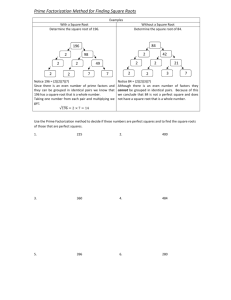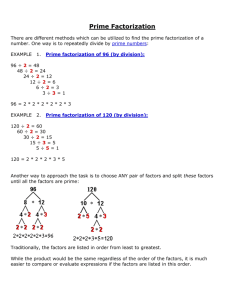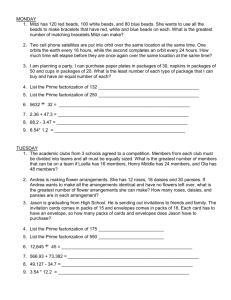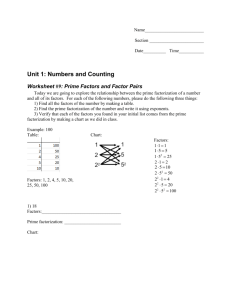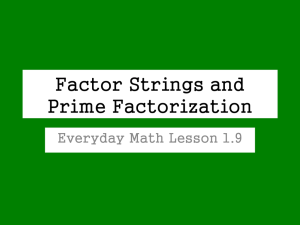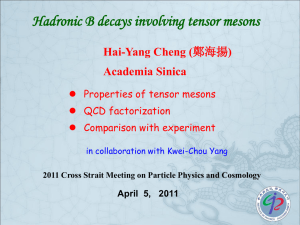V. Semileptonic B Decays
advertisement
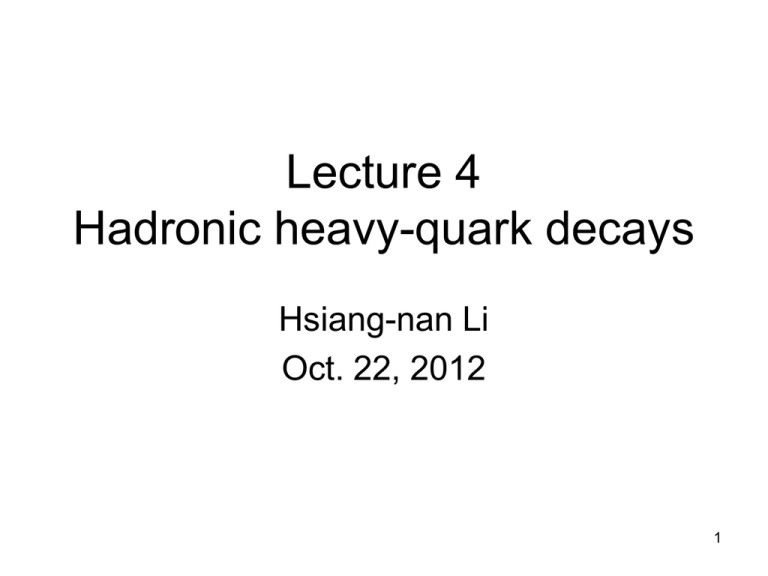
Lecture 4 Hadronic heavy-quark decays Hsiang-nan Li Oct. 22, 2012 1 Outlines • • • • • Naïve factorization QCD-improved factorization Perturbative QCD approach Strong phases and CP asymmetries Puzzles in B decays 2 Introduction • Why B physics? Constrain standard-model parameters CKM matrix elements, weak phases Explore heavy quark dynamics Form factors, penguins, strong phases Search for new physics SUSY, 4th generation, Z’… • Need B factories and critical comparison between data and QCD theories. 3 Cabbibo-Kobayashi-Maskawa Matrix Weak phase, CP 4 CP violation • Thumb only on the right---P violation • Thumbs on the right of right hand, and on the left of left hand---CP conservation • God is fair: He gives L to particle and R to antiparticle. • CP conserved here? • If she loses one Antiparticle arm, CP at 10-3 particle Thousand-hand 5 Guan Yin B transition form factors 6 Form factors • Measurement of structure of a bound state b point particle -> constant strength • If bound state, effective strength dependent on momentum transfer • It is like structure functions in DIS • Are form factors calculable? 7 Nonleptonic decays • Much more complicated • Involve scales mW, mb~Q, and • Are they calculable? 8 Naïve factorization 9 Effective Hamiltonian • First step, derive effective weak Hamiltonian by integrating out mW • Dynamics with scale mW is organized into Wilson coefficient Ci • The rest dynamics lower than mW goes into 4-fermion operators Oi Buras,Buchalla, 1995 • H=VCKMiCi()Oi() • Their (factorization scale) dependence cancels. 10 Diagrams at scale mW b penguin box also contributing to B-Bbar mixing 11 Factorization assumption A= < D|Heff|B> ~ C() <D|O()|B> FA was proposed to deal with the hadronic matrix element (Bauer, Stech, Wirbel 85). f FBD Color-allowed fD FB form factor not calculable Color-suppressed A( B D ) a1 f F BD a2 f D F B a1 C2 C1 NC , a2 C1 C2 NC C1 ~ 0.3, C2 ~ 1 12 Color transparency B D Lorentz contraction small color dipole decoupling in space-time from the BD system Nonfactorizable corrections negligible for color-allowed amplitudes. Expect large corrections in color-suppressed modes due to heavy D, large color dipole. No strong phase. No systematic improvement of precision 13 Incompleteness of FA • FA cannot be complete: form factor and decay constant are physical, independent of . Predictions depend on via C(). • Nonfactorizable contributions must exist, especially in color-suppressed modes. They may be small in color-allowed decays, which are insensitive to . • Power corrections, like strong phases, are crucial for CP violation. • FA was used for decades due to slow experimental and theoretical progress. 14 Go beyond FA • Great experimental (Babar, Belle) and theoretical (factorization approaches) progress around 2000. • Rare (including color-suppressed) decays with BR down to 10-6 and CP asymmetries can be measured precisely at B factories. • Explore nonfactorizable and power corrections, or even new physics. • Theorists need to go beyond FA. 15 Theoretical approaches • Hadronic B decays involve abundant QCD dynamics of heavy quarks. • Complexity of B decays dragged theoretical progress till year 2000, when we could really go beyond naïve factorization. • Different approaches developed: PQCD, QCDF, SCET. • Predictive power and data discriminate 16 different approaches. QCD-improved factorization Beneke, Buchalla, Neubert, Sachrajda, 1999 17 QCD corrections to FA • Add gluons to FA • Nonfactorizable corrections appear at this order 18 Hard kernels • TI comes from vertex corrections x q 1 Magnetic penguin O8g • TII comes from spectator diagrams soft divergences cancel in pairs 19 QCDF • Based on collinear factorization • Compute corrections to FA, ie., the heavyquark limit. distribution amplitude like PDF in DIS perturbative nonperturbative • Due to end-point singularity in collinear factorization 20 B -> form factors • x runs from 0 to 1. The end-point region is unavoidable. • Collinear factorization gives end-point singularity. Form factors not calculable PB-xP k-xP k 1 0 xP ( x) dx 2 , x ( x) x(1 x) 21 Breakthrough and challenge • It is amazing that higher-order corrections to FA are calculable! • Study of two-body hadrnic B decays can be improved systematically • But, when going to higher powers, challenge appeared…. • End-point singularity avoided by absorbing it into form factors, but reappeared at higher powers 22 End-point singularity • Singularity appears at O(1/mb), twist-3 spectator and annihilation amplitudes, parameterized as X=(1+ ei)ln(mb/) • For QCDF to be predictive, O(1/mb) corrections are better to be small ~ FA. • Data show important O(1/mb). Different free (,) must be chosen for B-> PP, PV, VP. 23 Perturbative QCD approach Keum, Li, Sanda, 2000 24 kT factorization • If no end-point singularity, collinear factorization works. If yes, small x region is important, and kT factorization is more appropriate. • kT factorization for exclusive processes is basically the same as for inclusive process (small x physics). • Based on collinear and kT factorizations, QCDF and PQCD have been developed for exclusive B decays. 25 Smearing of end-point singularity • Including parton kT accumulated through gluon emissions 1/(xmB2+kT2) B x, kT x’, 0T 1 0 1 dx x kT2 mB2 is finite 26 Factorization of form factor • Form factors are calculable, if TMD is known b F B TMD • Factorization of two-body hadronic B decays changed! 27 Three scales • Start with lowest order diagram for B -> D d u • This amplitude Winvolves three u b dramatically different g scales: mW, mb, and • Radiative corrections generate large logs ln(mW/mb), ln(mb/), which must be summed to all orders to improve perturbation. 28 Two clusters of corrections • Two clusters d u Generate ln(mW/mb) Wu b Generate ln(mb/) g • Sum ln(mW/mb) first (integrating out W boson), giving effective weak Hamiltonian, and then sum ln(mb/), giving Sudakov and RG evolutions. • PQCD approach incorporates factorizations of effective weak Hamiltonian and IR divergences. 29 Effective Hamiltonian • also a kind of factorization theorem. is renormalization scale b Full diagram Soft (effective) diagram 4-fermion operator O2 independent dependent Hard part Wilson coefficient dependent • Radiative corrections give new operators (operator mixing) O1 -> O1,O2 • Effective Hamiltonian Different color flows -> CKM matrix elements 30 QCD and EM penguins • Radiative corrections also introduce QCD and electroweak penguins 31 Factorization of IR divergence • Use soft divergence for demonstration. full diagram current conservation f-independent soft diagram eikonalized f-dependent • Factorization formula hard part f-dependent f is factorization scale TMD wave function hard kernel 32 Three-scale factorization for any gluon, isolate IR divergence first Precisely speaking, it is cancelled by another gluon then shrink W line to get effective Hamiltonian hard scale t2 ~mb • A=C(mW,) * H(t,,f) * (f,1/b) can choose = f 33 Four scales actually • Strictly speaking, there are 4 scales: mW, d mb, t ~ (mb)^(1/2), . • There are 3 clusters. The Wu cluster of hard kernel b g splits into one for weak b ->u vertex, and another for hard gluon. • The above are scales in Soft-Collinear Effective Theory u 34 Feynman diagrams emission diagrams annihilation diagrams 35 Sudakov effect increases kT suppression at large b becomes stronger at larger energy Small x • Physical picture: large b means large color dipole. Large dipole tends to radiate during hard scattering. No radiation in exclusive processes. Small b configuration preferred. 36 Strong phase and CP violation annihilation marks most crucial difference between QCD and PQCD 37 (V-A) and (V+A) currents • For (V-A)(V-A), left-handed current spin (this configuration is not allowed) fermion flow b p2 p1 momentum • Pseudo-scalar B requires spins in opposite directions, namely, helicity conservation 1=s1. p1=(-s2 ) .(-p2 ) =2 . • For (V-A)(V+A)=(S-P)(S+P), scalar current b Survive helicity conservation, 38 Small annihilation? • • • • Annihilation is of higher power But what is the power suppression factor? If /mB , annihilation is negligible But it turns out to be 2m0/mB ~ 0.6 for 2 m m0 1.5 GeV mu md • Introduced by pseudoscalar-current matrix element (for twist-3 DA S) • What is impact of sizable annihilation? 39 Principle value Loop line can go on-shell B Strong phase kT loop with the weight factor from kT distribution function (TMD) Bander-Silverman-Soni mechanism, strong phase source in FA 40 Sources of strong phase Annihilation is assumed to be small, down by s/mb in QCDF, but calculable and sizable in PQCD Different sources lead to different direct CP asy. 41 Large strong phase • ACP(K+-)~ -0.1 implies sizable T ~ 15o between T and P from annihilation (PQCD, 00) T exp(i3) If T=0 T exp(i3) If T=0 Br P T exp(-i3) Br = Br P T exp(-i3) Br = Br Direct CP 42 43 Ali et al., 2007 QCDF prediction smaller by an order of magnitude 44 45 46 47 Direct CP asymmetries, pure annihilation branching ratios, B->VV polarizations all indicate sizable annihilation 48 Puzzles in B decays 49 Puzzles in B physics • B( ), B( ) much larger than 0 0 0 0 predictions 0 • ACP ( K ) much different from ACP ( K ) • S ( 0 K S ) lower than S (cc s ) • New physics or QCD effect? • If new physics, how about B( 0 0 ), B( 0 0 ) 0 0 B ( ) is normal • If QCD, but • How to resolve these puzzles? 50 Quark amplitudes 2 color traces Nc2 b W 1 color trace Nc d,s u u u u d,s Color-allowed tree T g QCD penguin P Color-suppressed tree C d,s d,s u u u , Z u Electroweak penguin Pew 51 K parameterization (C2/C4)(VusVub/VtsVtb) ~ (1/2)(5/2) ~ 52 53 Explanation 1 • How to understand positive ACP(K+0)? • Large PEW to rotate P (Buras et al.; Yoshikawa; Gronau and Rosner; Ciuchini et al., Kundu and Nandi) new physics? T exp(i3) P T exp(-i3) PEW 54 Explanation 2 • Large C to rotate T (Charng and Li; He and McKellar). mechanism missed in naïve power counting? • C is subleading by itself. Try NLO…. An not-yet-finished story (T+C) exp(i3) T exp(i3) P (T+C) exp(-i3) 55 Summary • Naïve factorization of hadronic B decays relies only on color transparency. • Fully utilize heavy-quark expansion. Combine effective Hamiltonian (separation of mW and mb) and IR divergence factorization (separation of mb and ). • Factorization theorem can explain many data, but some puzzles remain • New physics or complicated QCD dynamics? More hard working is needed 56


